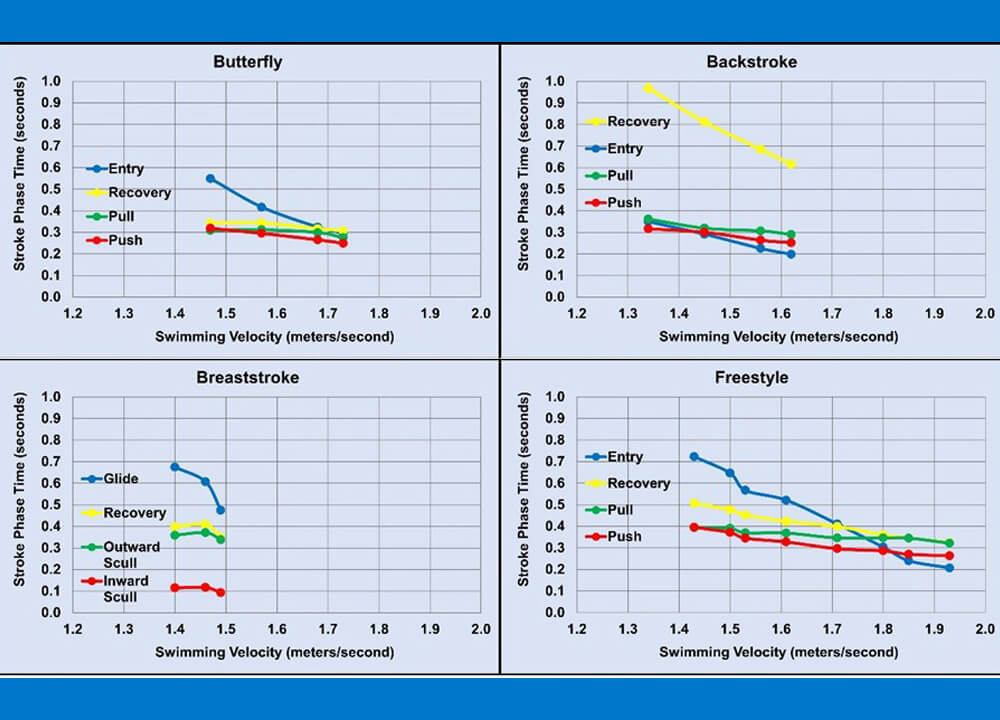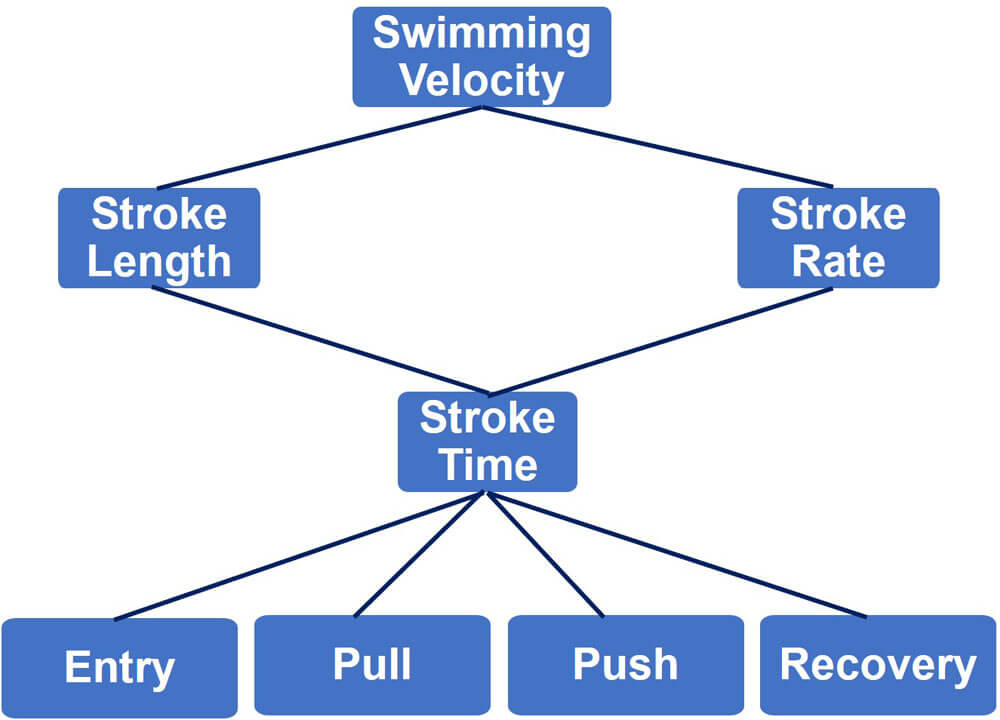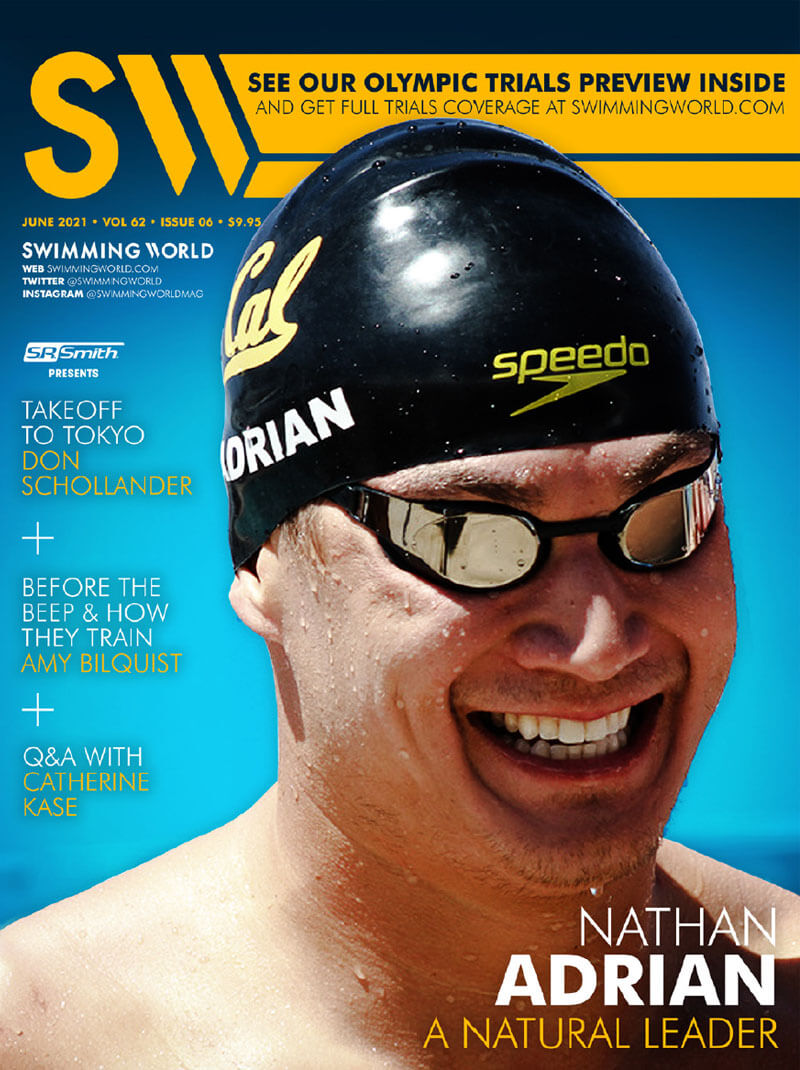Swimming World Presents – Swimming Technique Concepts: Maximizing Swimming Velocity Part 2 – Stroke Cycle Phase

The latest issue of Swimming World Magazine
is now available for download in the Swimming World Vault!
Non-Subscribers Can Download This Issue Here
Maximizing Swimming Velocity Part 2 – Stroke Cycle Phase
By Rod Havriluk
As explained in Part 1 of this series (SW May 2021), stroke rate and stroke length typically vary inversely. When a swimmer increases stroke rate, he/she usually decreases stroke length. When a swimmer increases stroke length, he/she usually decreases stroke rate.
The previous article also explained the relationship of stroke time (the time for an arm to complete a stroke cycle) to both stroke rate and stroke length. This article identifies the component phases of stroke time and potential changes to improve performance.

FIG. 1 > Swimming velocity is the product of stroke length and stroke rate, which are both related to stroke time. The four phases of stroke time are entry, pull, push and recovery.
STROKE TIME
The inverse relationship between stroke length and stroke rate is primarily because both variables are directly related to
the time for each stroke cycle (stroke time), as shown in Fig. 1. A decrease in stroke time increases stroke rate, while an increase in stroke time increases stroke length. This makes it a challenge to optimize stroke time for the fastest swimming velocity.
STROKE TIME PHASES
Strategies to optimize stroke time become apparent from analysis of the component phases. Each stroke cycle includes two propulsive phases (pull and push) and two non-propulsive phases (entry and recovery), also shown in Fig. 1. The four phases of the freestyle stroke cycle were previously defined (Chollet, Chalies & Chatard, 2000):
• Entry: from when the hand enters the water until the beginning of backward hand motion
• Pull: from the beginning of backward hand motion until the hand passes beneath the vertical plane of the shoulder
• Push: from when the hand passes beneath the vertical plane of the shoulder until the hand’s release from the water
• Recovery: from the hand’s release from the water until it enters the water
Although the stroke cycle phases were originally developed for freestyle, they also apply to butterfly and backstroke. Similarly, the breaststroke cycle has four phases with two propulsive (outward and inward sculling motions) and two non-propulsive (recovery and glide) components.
STROKE TIME DECREASE WITH SWIMMING VELOCITY INCREASE

FIG. 2 > The graphs show the decrease in the duration of all four stroke phases with an increase in swimming velocity for all four strokes.
Numerous studies show similar changes in the duration of each stroke phase with an increase in swimming velocity. For example, elite male swimmers increased swimming velocity on a series of swims from distance to sprint pace in all four strokes. The results are shown in Fig. 2 for butterfly (Chollet, Seifert, Boulesteix, Carter, 2006), backstroke (Chollet, Seifert, Carter, 2008), breaststroke (Leblanc, Seifert, Baudry & Chollet, 2005) and freestyle (Seifert, Chollet & Bardy, 2004).
To swim faster, swimmers naturally move their arms faster. Consequently, there is a decrease in the time duration for each of the four phases for all strokes from distance to sprint pace.
To read more about swimming velocity and stroke cycle phases, including sprint pace,
Click here to download the full June 2021 Issue of Swimming World
Dr. Rod Havriluk is a sport scientist and consultant who specializes in swimming technique instruction and analysis. His newest ebooks in the “Approaching Perfect Swimming” series are “Optimal Stroke Technique” and “Swimming Without Pain,” and are available at swimmingtechnology.com. Contact Rod through info@swimmingtechnology.com. All scientific documentation relating to this article, including scientific principles, studies and research papers, can be provided upon demand.
Get Swimming World Magazine and Swimming World Biweekly FREE When You
Become A Member of the International Swimming Hall of Fame
New! 30 Day Membership to ISHOF AND Digital Swimming World Subscription for just $10 a month!
Want more? Get a 1 Year ISHOF Family Membership With Swimming World Print AND Digital Subscription Order Now!
Non-Subscribers can click here to download this issue for only $5.94
Swimming World June 2021 Issue
FEATURES
12 | U.S. OLYMPIC TRIALS PREVIEW
by David Rieder
The fastest swimmers in the United States will be putting their hopes and dreams on the line at the U.S. Olympic Team Trials-Swimming, June 13-20, in Omaha, Neb. If realized, they’ll have the opportunity to perform next month on the world’s grandest stage: the Olympic Games in Tokyo.
22 | A NATURAL LEADER
by John Lohn
Still producing elite-level performances, Nathan Adrian, now 32 and pursuing his fourth Olympic Games, has the opportunity to further his already lofty reputation. And whenever his days in the sport come to an end, Adrian will be viewed for his excellence in the sport as an athlete, teammate and ambassador.
25 | NJCAA CHAMPIONSHIPS: QUALITY & QUANTITY
by Andy Ross
That’s the same winning formula that Indian River’s men’s and women’s swimming and diving teams have been using for nearly a half-century at the NJCAA Championships. The Pioneer men now have won 47 straight team titles; the women, 39—and 43 of the past 47.
26 | TAKEOFF TO TOKYO: A FORGOTTEN STAR
by John Lohn
By all measures, Don Schollander is a legend in the sport, a Hall of Fame talent who was unrivaled in his heyday. Yet, his impact has been lost to a combination of unfortunate timing and modern-day fascination.
29 | DOMINANCE AND PARITY ON DISPLAY IN TOKYO
by Dan D’Addona
While the U.S. women have dominated international water polo since 2015—winning their second straight Olympics in 2016 plus three World Championships in 2015-17-19—a different men’s champion has emerged at each of the last three major international competitions—Serbia (2016 Olympics), Croatia (2017 Worlds) and Italy (2019 Worlds).
30 | ISHOF: REMEMBERING THE KALILI BROTHERS—90 YEARS AGO
by Bruce Wigo
As kids who preferred to dive for coins rather than race in a swimming pool, brothers Maiola and Manuella Kalili from Hawaii would eventually become national champions and Olympic silver medalists in 1932.
33 | NUTRITION: HOW MANY CALORIES SHOULD I EAT?
by Dawn Weatherwax
As long course, Olympics and endurance events get underway, a common question is: “How much do I need to eat?” This is a loaded question—one in which the author will try to simplify.
35 | MENTAL PREP: BEFORE THE BEEP WITH AMY BILQUIST
by Shoshanna Rutemiller
COACHING
38 | SWIMMING TECHNIQUE CONCEPTS: MAXIMIZING SWIMMING VELOCITY (Part 2)—STROKE CYCLE PHASES
by Rod Havriluk
Swimmers typically decrease non-propulsive time to decrease stroke time, increase stroke rate and swim faster. Research shows that a further decrease in the non-propulsive time is possible and should produce further performance improvement.
40 | A COACHES’ GUIDE TO ENERGY SYSTEMS
by Michael J. Stott
In the first of two parts, Swimming World explores the concept of energy systems and how coaches can use them to maximize athlete development and performance.
42 | SPECIAL SETS: KATIE LEDECKY—RUN-UP TO RIO 2016
by Michael J. Stott
With this month’s Olympic Swimming Trials now upon us, Swimming World takes a back-to-the-future approach to revisit some training done by superstar Katie Ledecky prior to the 2016 U.S. team qualifying meet.
44 | Q&A WITH COACH CATHERINE KASE
by Michael J. Stott
45 | HOW THEY TRAIN HALEY ANDERSON
by Michael J. Stott
TRAINING
037 | DRYSIDE TRAINING: TRAINING AMY BILQUIST
by J.R. Rosania
JUNIOR SWIMMER
47 | UP & COMERS: KEELAN COTTER
by Shoshanna Rutemiller
COLUMNS
08 | A VOICE FOR THE SPORT
11 | DID YOU KNOW: ABOUT BUSTER CRABBE?
48 | GUTTERTALK
49 | PARTING SHOT
Swimming World is now partnered with the International Swimming Hall of Fame. To find out more, visit us at ishof.org




